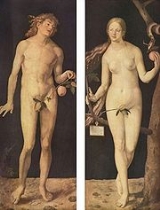
, created by YHWH, the God of the ancient Hebrews
. Adam
and Eve
ate fruit from the tree of the knowledge of good and evil, causing their expulsion from the Garden of Eden
.
"It is not good that the man should be alone; I will make him a helper as his partner." - Genesis 2:18
The language of sexuality and gender distinction is not used explicitly until the woman is created in Genesis 2:22-24.
Adam and Eve had many advantages, but the principle one was that they escaped teething.![]()
Adam and Noah were ancestors of mine. I never thought much of them. Adam lacked character. He couldn't be trusted with apples. Noah had an absurd idea that he could navigate without any knowledge of navigation, and he ran into the only shoal place on earth.![]()
“Adam knew Eve his wife and she conceived.” It is a pity that this is still the only knowledge of their wives at which some men seem to arrive.![]()
Adam, man's benefactor — he gave him all he has ever received that was worth having — Death.![]()
Adam was but human — this explains it all. He did not want the apple for the apple's sake, he wanted it only because it was forbidden. The mistake was in not forbidding the serpent; then he would have eaten the serpent.![]()
After all these years, I see that I was mistaken about Eve in the beginning; it is better to live outside the Garden with her than inside it without her.![]()
Ever since Eve gave Adam the apple, there has been a misunderstanding between the sexes about gifts.![]()
It all began with Adam. He was the first man to tell a joke — or a lie. How lucky Adam was. He knew when he said a good thing, nobody had said it before. Adam was not alone in the Garden of Eden, however, and does not deserve all the credit; much is due to Eve, the first woman, and Satan, the first consultant.![]()
Let us be thankful to Adam our benefactor. He cut us out of the 'blessing' of idleness and won for us the 'curse' of labor.![]()

